Nebraska is a beautiful state in the Midwestern region of the United States. With its vast plains and the stunning Panhandle, there are many areas for animals to make themselves at home in the state. Although the largest animal you can find in Nebraska is the huge American bison, there are also many smaller animals too — including snakes. In fact, there are 30 different species of snakes in the state, including four that are venomous. Therefore, if you’re out exploring then you’ll need to know which ones are which. So, join us as we identify some of the black snakes in Nebraska for you!

1. Western Massasauga (Sistrurus catenatus tergeminus)

Western massasauga rattlesnakes are overlaid by dark brown to black blotches.
©iStock.com/Shoemcfly
We’ll begin with the first of two venomous snakes on the list: the western massasauga, which is a subspecies of the massasauga rattlesnake. These snakes are only found in the southeastern corner of Nebraska, where they live in grasslands, open woodlands, and on rocky hillsides. Western massasaugas have a light grey or tan ground color that is overlaid with a series of dark brown to black blotches. They are fairly small — ranging between 14 and 36 inches — but contain a hemotoxic venom that is more powerful than that of many larger rattlesnakes. However, due to their small size, this is somewhat counteracted by their lower venom yield.
2. Timber Rattlesnake (Crotalus horridus)
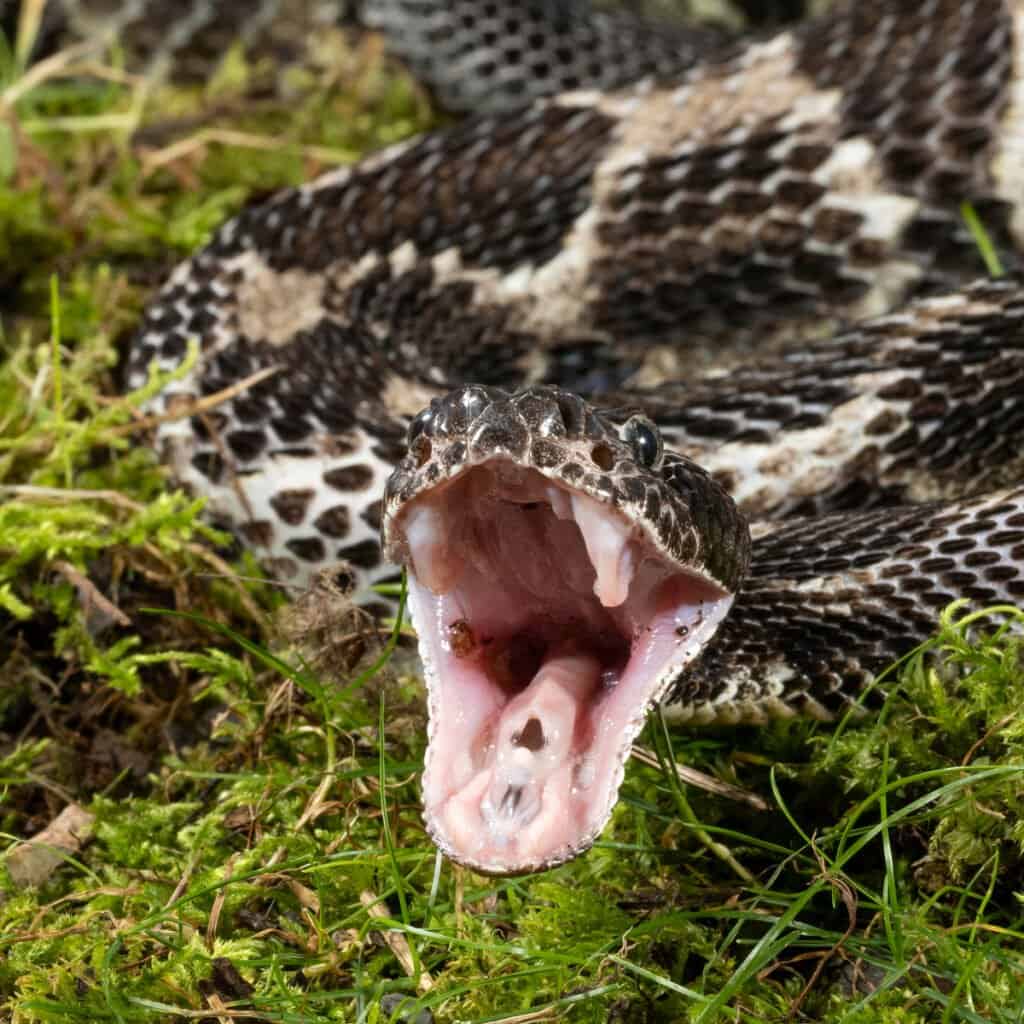
Timber rattlesnakes are venomous and usually 36 to 60 inches long.
©Joe McDonald/Shutterstock.com
The second venomous snake is the timber rattlesnake, which again only lives in the far southeast corner of the state. Timber rattlesnakes typically live in woodlands or in rocky areas that they use as basking knolls. They are usually 36 to 60 inches long and have brown bodies with dark brown to black crossbands. Timber rattlesnakes are extremely venomous. However, they don’t have a naturally aggressive nature and prefer to flee from danger when they are threatened.
3. Black Rat Snake (Pantherophis obsoletus)
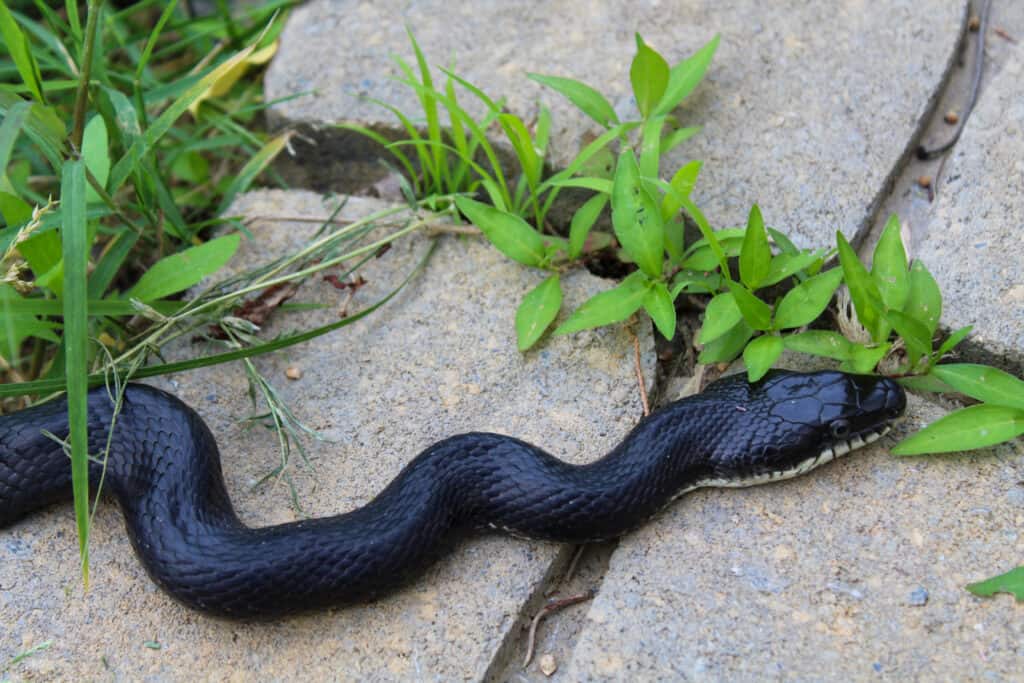
Black rat snakes’ preferred habitats are woodlands, prairies, and rocky outcrops.
©ButtermilkgirlVirginia/Shutterstock.com
Another black snake in Nebraska is the black rat snake, which is also known as the western rat snake. These snakes are 42 to 72 inches long. They have a distinctive appearance with black bodies and white markings on their chin, lips, and throat. However, despite their appearance as adults, juveniles are usually grey with brown blotches and their color darkens as they get older. Black rat snakes only live in the most eastern regions of the state. Their preferred habitats are woodlands, prairies, and rocky outcrops. They are not venomous and kill by constriction, with rodents making up the majority of their diet.
4. Eastern Hognose Snake (Heterodon platirhinos)
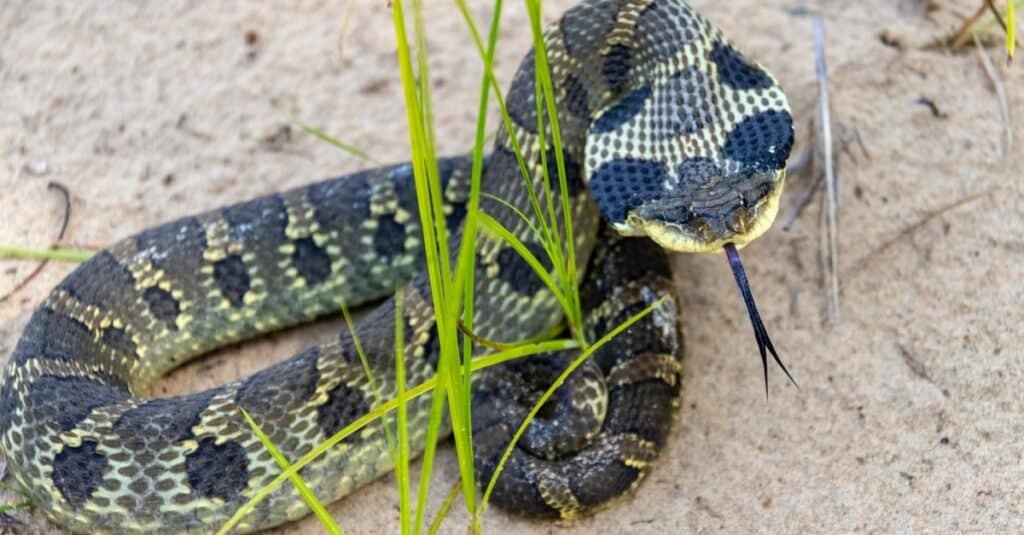
The eastern hognose snake will flatten its head and neck and hiss loudly when threatened.
©IHX/Shutterstock.com
The eastern hognose snake is a snake with an unusual appearance, having a distinctly upturned snout. They use this to dig and burrow into loose soil usually in woodlands and around forest edges along the eastern edge of the state. Eastern hognose snakes usually reach 20 to 33 inches long. They are black, grey, brown, or red with either dark brown or black blotches on their bodies. They are not venomous but often mimic dangerous snakes when they are threatened by flattening their neck and hissing, which has earned them the nickname of the spreading adder. However, if that doesn’t work then they are known to simply roll over and play dead. Talk about being dramatic!
5. Speckled Kingsnake (Lampropeltis holbrooki)
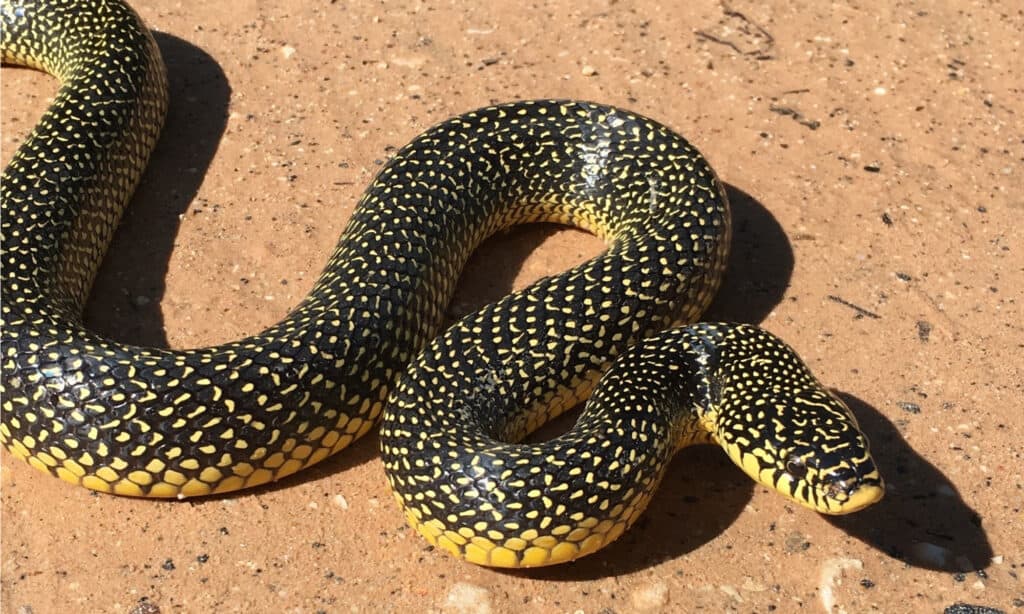
The speckled kingsnake has a glossy black body with whitish-yellow dots on its scales.
©Joe Farah/Shutterstock.com
A snake with a particularly stunning appearance is the speckled kingsnake, which is black with yellow or white speckles in the middle of every dorsal scale. Speckled kingsnakes are large snakes and are typically 35 to 72 inches long. They mainly live in wet habitats in the extreme southeastern corner of Nebraska, such as swamps, wet prairies, and river bottoms. Despite not being venomous, speckled kingsnakes often mimic rattlesnakes by vibrating their tail in the leaf litter when they are threatened. They are constrictors and prey on small mammals, birds, lizards, amphibians, and other snakes.
6. Common Water Snake (Nerodia sipedon)
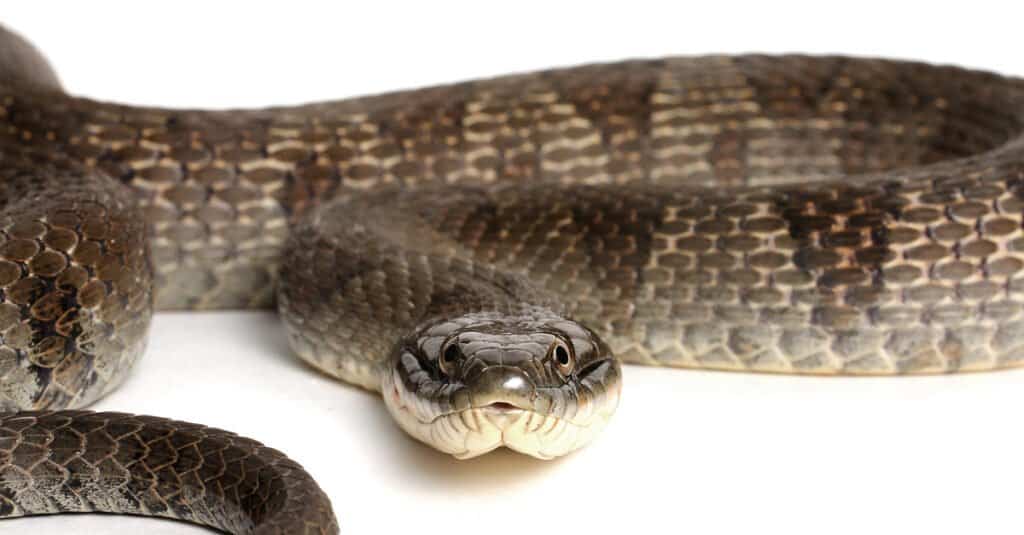
Common water snakes are non-venomous but can be aggressive and do bite if handled.
©Michiel de Wit/Shutterstock.com
Another black snake in Nebraska is the common (or northern) water snake. These snakes are highly aquatic. They occur in virtually any slow-moving wetland habitat across the majority of the state, with the exception of a small pocket in the western region. Common water snakes are 24 to 42 inches long and have dark brown to black bodies with even darker crossband markings. In other states, they are often mistaken for the venomous cottonmouth snake, although these don’t occur in Nebraska. However, common water snakes can be aggressive and do bite if handled, although they are not venomous.
7. Fox Snake (Pantherophis vulpinus)
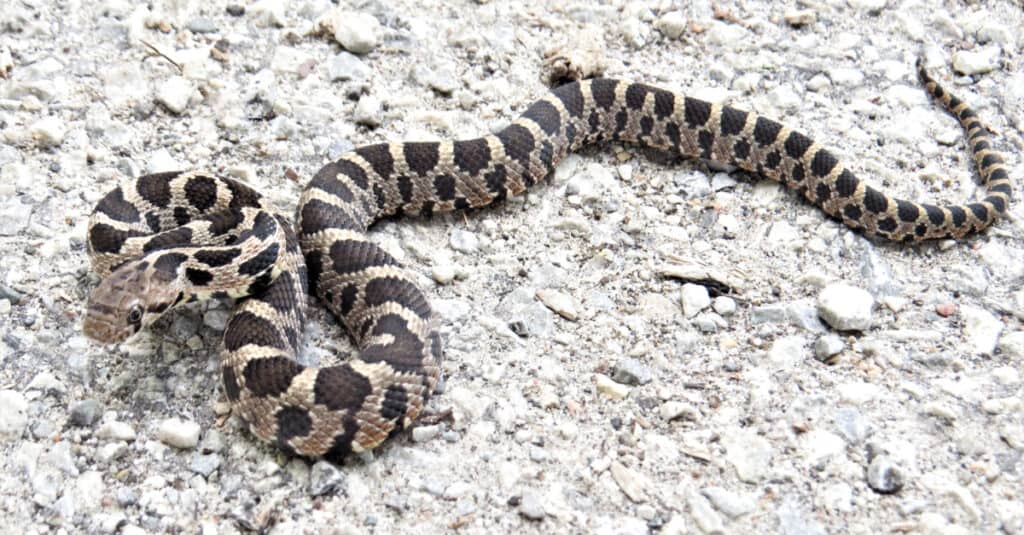
Fox snakes are large snakes that range between 36 and 72 inches long.
©ML Howard/Shutterstock.com
Named for the foul musk smell that they give off which resembles that of a fox, fox snakes are large snakes that range between 36 and 72 inches long. They are tan to golden brown with dark brown blotches. They also have yellow and black bellies. Fox snakes are found in the northeast region of the state where they live in grasslands, woodlands, prairies, and farmland. Fox snakes are diurnal and prey largely on rodents. This means they are often considered to be beneficial, particularly around farms.
8. Bullsnake (Pituophis catenifer sayi)
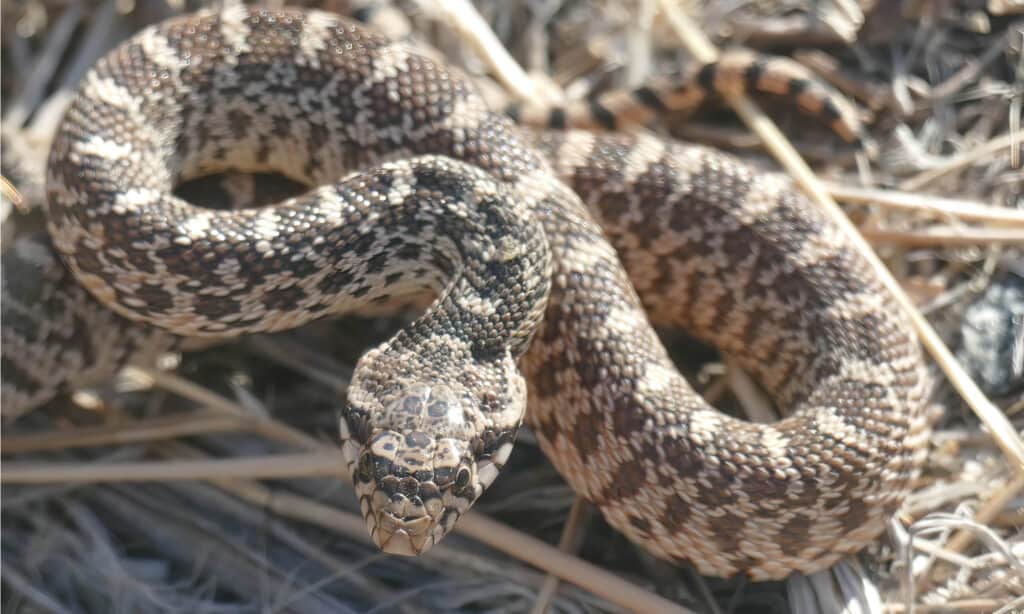
Bullsnakes are around 74 inches long and covered with black or dark brown blotches.
©steve estvanik/Shutterstock.com
The longest snake in Nebraska is the bullsnake, which is a subspecies of the gopher snake. Bullsnakes are approximately 74 inches long and have yellow bodies which are covered with large black or dark brown blotches. They are found across the entire state and mainly live in grasslands, prairies, and woodlands. However, they are known to encroach on suburban areas, too. Bullsnakes are not dangerous and prey mainly on small mammals, birds, and lizards. However, they sometimes adopt a defensive posture by raising their head and neck while vibrating their tail.
9. Ring-Necked Snake (Diadophis punctatus)
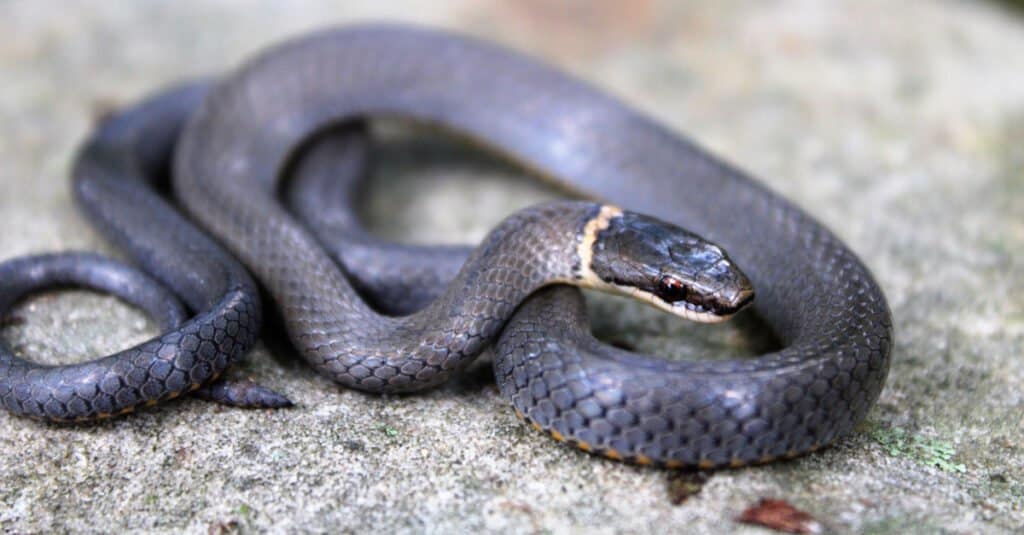
Ring-necked snakes are completely back except the ring on their necks.
©Tucker Heptinstall/Shutterstock.com
From one of the longest black snakes in Nebraska, we now move on to one of the smallest: the ring-necked snake. Ring-necked snakes are only 10 to 20 inches long and have slender bodies and distinctive appearances. They are usually completely black with the exception of a brightly-colored orange, red, or yellow ring around their neck. However, its belly can sometimes be the same color as its neck. Ring-necked snakes live mainly in forests, woodlands, and grasslands across the eastern half of Nebraska. However, they are nocturnal and very shy so it is unlikely that you will manage to spot this unique little snake.
10. Western Ribbon Snake (Thamnophis proximus)
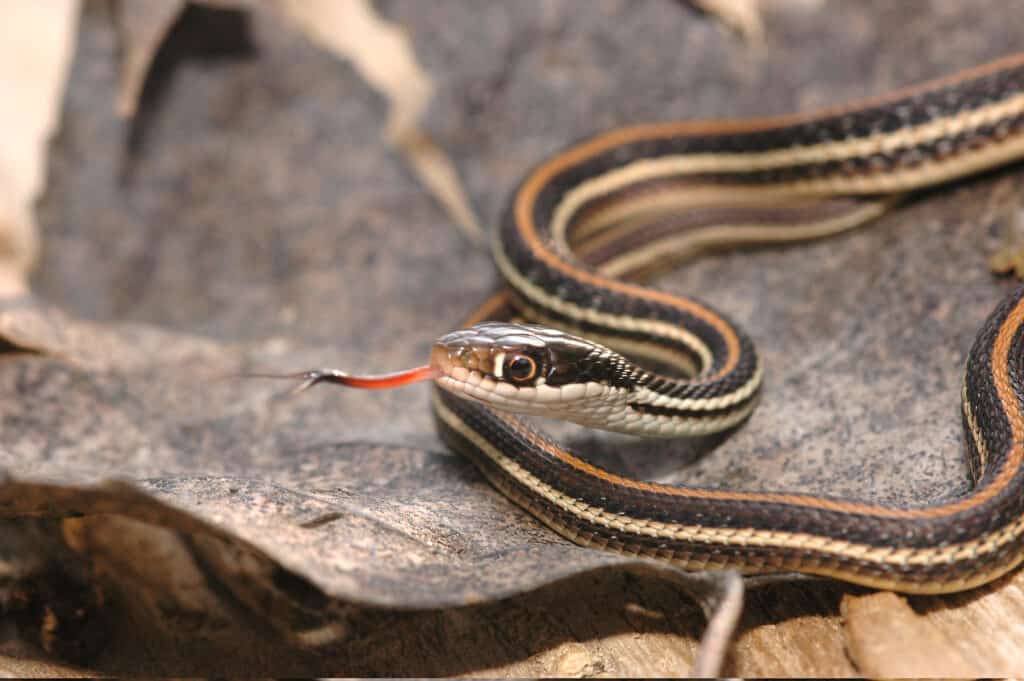
Western ribbon snakes have black, brown, or green bodies with three yellow or white stripes.
©iStock.com/Shoemcfly
The final black snake in Nebraska is the western ribbon snake, which is a type of garter snake. Western ribbon snakes live mainly in prairies and meadows near permanent bodies of water in the southeastern corner of the state. They are 17 to 50 inches long and have black, brown, or green bodies with three yellow or white stripes. Western ribbon snakes are not venomous and prey on fish, amphibians, and lizards.
Summary of 10 Black Snakes in Nebraska
Here’s a recap of 10 top black snakes found in Nebraska that we took a look at.
| Number | Snake | Scientific Name | Range in Nebraska |
|---|---|---|---|
| 1 | Western Massasauga | Sistrurus catenatus tergeminus | Only in southeastern corner of Nebraska in grasslands, open woodlands, and on rocky hillsides |
| 2 | Timber Rattlesnake | Crotalus horridus | Far southeast corner of the state in woodlands or in rocky areas |
| 3 | Black Rat Snake | Pantherophis obsoletus | Most eastern regions of the state in woodlands, prairies, and rocky outcrops |
| 4 | Eastern Hognose Snake | Heterodon platirhinos | Woodlands and around forest edges along the state’s eastern edge |
| 5 | Speckled Kingsnake | Lampropeltis holbrooki | Wet habitats in the extreme southeastern corner of Nebraska such as swamps, wet prairies, and river bottoms |
| 6 | Common Water Snake | Nerodia sipedon | Slow-moving wetland habitats across the majority of the state |
| 7 | Fox Snake | Pantherophis vulpinus | Northeast region of the state in grasslands, woodlands, prairies, and farmland |
| 8 | Bullsnake | Pituophis catenifer sayi | Statewide, mainly in grasslands, prairies, and woodlands |
| 9 | Ring-Necked Snake | Diadophis punctatus | Forests, woodlands, and grasslands across the eastern half of Nebraska |
| 10 | Western Ribbon Snake | Thamnophis proximus | Mainly in prairies and meadows near bodies of water in the state’s southeastern corner |
The photo featured at the top of this post is © Tucker Heptinstall/Shutterstock.com
Discover the "Monster" Snake 5X Bigger than an Anaconda
Every day A-Z Animals sends out some of the most incredible facts in the world from our free newsletter. Want to discover the 10 most beautiful snakes in the world, a "snake island" where you're never more than 3 feet from danger, or a "monster" snake 5X larger than an anaconda? Then sign up right now and you'll start receiving our daily newsletter absolutely free.
Sources
- UNIVERSITY of NEBRASKA–LINCOLN, Available here: https://herpneb.unl.edu/fox-snake
- UNIVERSITY of NEBRASKA–LINCOLN (1970) herpneb.unl.edu/timber-rattlesnake-venomous
- UNIVERSITY of NEBRASKA–LINCOLN, Available here: https://herpneb.unl.edu/eastern-hog-nosed-snake
- UNIVERSITY of NEBRASKA–LINCOLN, Available here: https://herpneb.unl.edu/common-water-snake
Thank you for reading! Have some feedback for us? Contact the AZ Animals editorial team.






